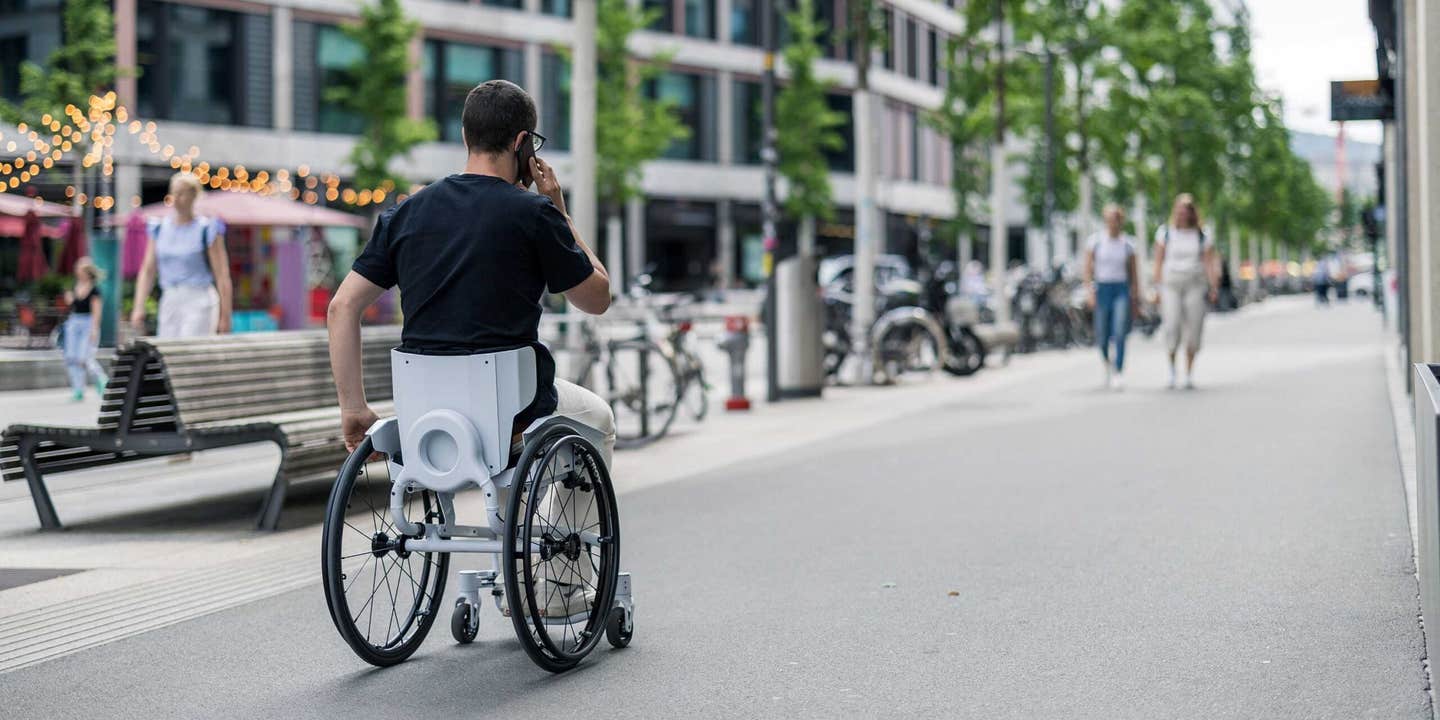Lifechanging wheelchair uses hands-free backrest-based steering
ETH Zurich researchers developed a wheelchair with backrest steering, allowing users to steer by leaning reducing energy use and joint strain

Users of the wheelchair can both steer and propel the chair forward while still keeping one hand free for other tasks. (CREDIT: Reto Togni & Stefan Villiger / ETH Zurich)
For many people, wheelchairs and shopping trolleys seem unrelated. Yet, if you look closely, both share a key design feature: freely rotating front wheels. These wheels, designed to increase agility, have a downside—on uneven surfaces, steering becomes a constant struggle.
Just as pushing a full shopping trolley along a slanted sidewalk pulls you off course, manual wheelchair users experience similar difficulties. They often need to use one hand to accelerate and the other to steer or brake, causing fatigue and joint strain over time.
Researchers Reto Togni and Stefan Villiger from ETH Zurich's Laboratory for Movement Biomechanics recognized this problem and devised a clever solution: a wheelchair with a moveable backrest that functions as a steering mechanism.
By simply leaning to the right or left, users can easily steer the chair in that direction, reducing the need for constant manual adjustments. This innovation could significantly enhance mobility, comfort, and energy efficiency for wheelchair users. “This saves a lot of energy and renders braking on pavements and at bends unnecessary,” Togni explains.
To test their idea, Togni and Villiger conducted trials in an underground car park on the Hönggerberg campus of ETH Zurich. During the trials, 29 participants navigated an obstacle course six times—first with a standard wheelchair and then with the new backrest-steered prototype.
Related Stories
Sensors in the large wheels measured how much energy the participants used to steer and move. The course included a straight path slanted at a five-degree angle, 180-degree turns, and a slalom.
The results were clear: steering with the backrest required significantly less energy. “In the first round, participants needed much less energy to steer with the backrest,” Togni notes. Villiger, who also participated, adds, “When I used the prototype on the slanted incline, I didn’t have to correct my steering with my hand once. It was also easier to navigate around bends.”
Data from the trials confirmed these impressions. When steering with the backrest, users braked less often and applied less driving energy. Surprisingly, they also moved faster than with a conventional wheelchair. This puzzled the researchers since, in most cases, higher speeds demand more energy.
Apart from saving energy, the backrest-steering system offers additional health benefits. Wheelchair users often suffer from shoulder, arm, and hand strain from years of pushing. Steering with the backrest could reduce these physical stresses.
Furthermore, the gentle movements required for backrest steering may stimulate blood flow, which could help alleviate issues like back pain or indigestion. The shifting body weight could also relieve pressure on the seat, helping to prevent pressure sores. Another benefit is that users can steer with one hand, leaving the other free to carry a phone, a drink, or an umbrella.
However, there is one drawback: the new steering mechanism is not ideal for tight spaces. Rotating on the spot and making sharp turns are more challenging than with conventional wheelchairs. To address this, Togni and Villiger designed a lever that allows users to switch the backrest steering on and off as needed.
Togni first thought of using the backrest for steering in 2017 while pursuing a Master’s degree in Innovation Design Engineering. His inspiration came from talking to wheelchair users about their experiences with assistive products.
One woman mentioned how nice it would be to sit back and enjoy the ride, while another expressed frustration at being overtaken by skateboarders. These conversations sparked Togni's idea. “Surely it must also be possible to steer a wheelchair by shifting one’s weight,” he thought, and began developing his first prototype.
Togni refined his design during his doctoral studies at ETH Zurich, collaborating with Villiger, who joined the project after learning about it during an internal presentation. Villiger, a mechanical engineering graduate, found the concept intriguing. “I was fascinated by this simple and yet very elegant solution,” he recalls. Together, they have developed several prototypes and secured a patent for their innovation.
Supported by an ETH Pioneer Fellowship, Togni and Villiger are working to bring their wheelchair to the market through their startup, Versive. They aim to have the wheelchair recognized by Swiss invalidity insurance by mid-2027. In the meantime, over 50 wheelchair users have tested the backrest-steering model, and many are impressed. “One test participant said it was the greatest improvement for wheelchair users since the invention of the wheel,” Togni proudly shares.
Paraplegic test participant Ursula Memmishofer has been using the Versive wheelchair for six months and now refuses to part with it. She appreciates how the backrest steering improves her experience, allowing for smoother movement without constant manual corrections.
If most forms of transportation, like cars and ships, have steering wheels, why shouldn’t wheelchairs? Togni and Villiger believe their innovation fills an important gap. “If we also think of a wheelchair as a means of transportation, then it makes obvious sense that this should also have one,” Togni argues.
The researchers have been asked many times why no one had thought of this earlier. Togni believes the reason is that wheelchairs have historically been viewed more as tools for transporting the sick and disabled than as personal mobility devices. This limited perspective may have slowed innovation in wheelchair design.
Despite their progress, Togni and Villiger face challenges ahead, particularly with manufacturing. Wheelchair components themselves are not expensive, but Swiss insurance regulations require that the devices be highly customizable to individual users, which complicates production.
For instance, a standard mid-range wheelchair can be assembled in hundreds of thousands of ways to meet specific user needs. “We need to find out how we can make adjusting the wheelchairs as efficient as possible while keeping them highly customizable,” says Togni.
Currently, the wheelchairs are only available to those who can pay out of pocket, but the researchers hope to soon gain approval from insurance providers. They are also seeking funds to support the launch of their product and expand their team.
While some in the wheelchair industry remain skeptical, Togni and Villiger are undeterred. They have data proving the effectiveness of their design and many test participants who prefer the backrest steering. One participant even joked, “If Swiss invalidity insurance doesn’t want to pay, just sell it as a toy. Your vehicle is definitely fun to use.”
Note: Materials provided above by The Brighter Side of News. Content may be edited for style and length.
Like these kind of feel good stories? Get The Brighter Side of News' newsletter.
Rebecca Shavit
Science & Technology Journalist | Innovation Storyteller
Based in Los Angeles, Rebecca Shavit is a dedicated science and technology journalist who writes for The Brighter Side of News, an online publication committed to highlighting positive and transformative stories from around the world. With a passion for uncovering groundbreaking discoveries and innovations, she brings to light the scientific advancements shaping a better future. Her reporting spans a wide range of topics, from cutting-edge medical breakthroughs and artificial intelligence to green technology and space exploration. With a keen ability to translate complex concepts into engaging and accessible stories, she makes science and innovation relatable to a broad audience.



